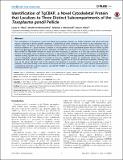Files in this item
Identification of TgCBAP, a novel cytoskeletal protein that localizes to three distinct subcompartments of the toxoplasma gondii pellicle
Item metadata
| dc.contributor.author | Tilley, Lucas D. | |
| dc.contributor.author | Krishnamurthy, Shruthi | |
| dc.contributor.author | Westwood, Nicholas J. | |
| dc.contributor.author | Ward, Gary E. | |
| dc.date.accessioned | 2014-08-12T10:01:01Z | |
| dc.date.available | 2014-08-12T10:01:01Z | |
| dc.date.issued | 2014-06-02 | |
| dc.identifier | 139785404 | |
| dc.identifier | 588dc101-5349-4550-ab77-cc759c05643f | |
| dc.identifier | 000336956300073 | |
| dc.identifier | 84902352598 | |
| dc.identifier | 000336956300073 | |
| dc.identifier.citation | Tilley , L D , Krishnamurthy , S , Westwood , N J & Ward , G E 2014 , ' Identification of TgCBAP, a novel cytoskeletal protein that localizes to three distinct subcompartments of the toxoplasma gondii pellicle ' , PLoS ONE , vol. 9 , no. 6 , e98492 . https://doi.org/10.1371/journal.pone.0098492 | en |
| dc.identifier.issn | 1932-6203 | |
| dc.identifier.other | ORCID: /0000-0003-0630-0138/work/56424131 | |
| dc.identifier.uri | https://hdl.handle.net/10023/5114 | |
| dc.description | This work was supported by US Public Health Service grant AI054961 (GEW). | en |
| dc.description.abstract | The cytoskeletons of Toxoplasma gondii and related apicomplexan parasites are highly polarized, with apical and basal regions comprised of distinct protein complexes. Components of these complexes are known to play important roles in parasite shape, cell division, and host cell invasion. During an effort to discover the biologically relevant target of a small-molecule inhibitor of T. gondii invasion (Conoidin A), we discovered a novel cytoskeletal protein that we named TgCBAP (Conserved Basal Apical Peripheral protein). Orthologs of TgCBAP are only found in the genomes of other apicomplexans; they contain no identifiable domains or motifs and their function(s) is unknown. As a first step toward elucidating the function of this highly conserved family of proteins, we disrupted the TgCBAP gene by double homologous recombination. Parasites lacking TgCBAP are as sensitive to the effects of Conoidin A as wild-type parasites, demonstrating that TgCBAP is not the biologically relevant target of Conoidin A. However, Delta TgCBAP parasites are significantly shorter than wild-type parasites and have a growth defect in culture. Furthermore, TgCBAP has an unusual subcellular localization, forming small rings at the apical and basal ends of the parasite and localizing to punctate, ring-like structures around the parasite periphery. These data identify a new marker of the apical and basal subcompartments of T. gondii, reveal a potentially novel compartment along the parasite periphery, and identify TgCBAP as a determinant of parasite size that is required for a maximally efficient lytic cycle. | |
| dc.format.extent | 8 | |
| dc.format.extent | 3002060 | |
| dc.language.iso | eng | |
| dc.relation.ispartof | PLoS ONE | en |
| dc.subject | Membrane complex | en |
| dc.subject | Parasite | en |
| dc.subject | Component | en |
| dc.subject | Apicomplexan | en |
| dc.subject | Dissection | en |
| dc.subject | Tools | en |
| dc.subject | Geen | en |
| dc.subject | QH301 Biology | en |
| dc.subject.lcc | QH301 | en |
| dc.title | Identification of TgCBAP, a novel cytoskeletal protein that localizes to three distinct subcompartments of the toxoplasma gondii pellicle | en |
| dc.type | Journal article | en |
| dc.contributor.institution | University of St Andrews. School of Chemistry | en |
| dc.contributor.institution | University of St Andrews. EaSTCHEM | en |
| dc.contributor.institution | University of St Andrews. Biomedical Sciences Research Complex | en |
| dc.identifier.doi | https://doi.org/10.1371/journal.pone.0098492 | |
| dc.description.status | Peer reviewed | en |
| dc.identifier.url | http://www.plosone.org/article/info%3Adoi%2F10.1371%2Fjournal.pone.0098492#s5 | en |
This item appears in the following Collection(s)
Items in the St Andrews Research Repository are protected by copyright, with all rights reserved, unless otherwise indicated.

